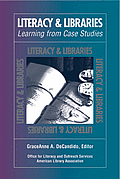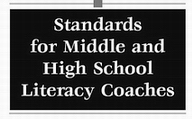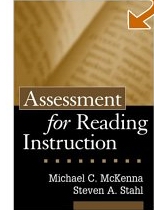
Bibliography Related to Literacy,
Illiteracy, and Resources
Site Map Close This Window
Literacy in Everyday Life: Results from the 2003 National Assessment of Adult Literacy.
The mother lode of all surveys, this assessment enables the deepest pockets of illiteracy to be visible - both at the county map level, and in terms of numbers that classify the level of reading skills. The 2003 National Assessment of Adult Literacy (NAAL) assessed English literacy skills of a nationally representative sample of more than 19,000 U.S. adults (age 16 and older) residing in households and prisons. NAAL is the first national assessment of adult literacy since the 1992 National Adult Literacy Survey.
Three types of literacy were measured: Prose, Document, and Quantitative. Results were reported in terms of scale scores (on a 500-point scale) and in terms of four literacy levels—Below Basic, Basic, Intermediate, and Proficient. This report, Literacy in Everyday Life, presents findings from the 2003 assessment. It examines changes in literacy levels for the total adult population of the United States, as well as for adults with different demographic characteristics (gender, race, age, and ethnicity). Changes in literacy levels are reported for 2003 as well as between 1992 and 2003.
Specifically, this report describes the relationship between literacy and a number of self-reported background characteristics including education, employment, earnings, job training, family literacy practices, civics activities, and computer usage. It examines the relationship between educational attainment and literacy and reports changes between 1992 and 2003. In addition, the relationship between literacy and adult education, including basic skills classes, English as a second language classes, and information technology certification is reported.
The findings discuss the relationship between literacy and employment status, occupation, weekly wage or salary, job training, and participation in public assistance programs. Moreover, the report examines how parents, grandparents, and guardians at different literacy levels interact with the children living in their homes around issues related to literacy and school.
Download, the Executive Summary with Chapters 1-2 pdf file (1,255kb)
Download, Chapters 3-6 pdf file (1,415kb)
Download, the Appendices pdf file (1,255kb)
 Teaching Adults to Read is a professional summary of the best research to date, valuable for teachers of Reading. PDF 20 pages.
Download Here
Teaching Adults to Read is a professional summary of the best research to date, valuable for teachers of Reading. PDF 20 pages.
Download Here
Put Reading First is a downloadable 66 page study of The Research Building Blocks for Teaching Children to Read
It is in PDF format (1.3MB), B/W PDF format (640KB).
Adult Literacy Assessment Tool Kit From the Illinois Literacy Resource Development Center by Suzanne Knell and Janet Scogins.
Adult literacy programs must prove that what they’re doing is working. The Adult Literacy Assessment Tool Kit provides everything you need to build an effective and accountable adult literacy program by showing how to analyze strengths and weaknesses and adapt accordingly. Field-tested by libraries around the country.
Information Here

Literacy and Libraries: Learning from Case Studies byGraceAnne A. DeCandido.
Literacy programs at libraries across the country have literally changed people's lives. Hear the real-life stories of library directors, program administrators, teachers, tutors, librarians, and adult learners who have experienced the transformation firsthand.With nine out of ten libraries playing a role in adult literacy and thirty percent offering instruction, it is ever-clear that libraries are major players in promoting and increasing literacy.
Information Here
The Teacher Who Couldn't Read: The True Story of a High School Instructor Who Triumphed over His Illiteracy by John Corcoran and Carole C. Carlson (Hardcover - Jul 1994)
Available Here The incredible true story of a smart kid who slipped through the system and became part of it. John Corcoran graduated from high school and college and went on to become a high school teacher--but he never learned how to read. Corcoran shares his amazing experiences of using deception to survive in a world of literates, and he clearly defines what schools, teachers, churches, and parents can do to conquer the little-known but widely spread disease of our educational system: illiteracy.

Standards for Middle and High School Literacy Coaches
The International Reading Association has this resource for teachers of reading. Professional quality and freely downloadable.
http://www.reading.org/downloads/resources/597coaching_standards.pdf
A Child Becomes a Reader Produced by RMC Research Corporation, by Armbruster, Fran Lehr, andJean Osborn, chronicles birth to age five. PDF 36 Pages.
Download Here
 Assessment for Reading Instruction (Solving Problems In Teaching Of Literacy) by Michael C. McKenna and Steven A. Stahl (Author)
From the comments: I'll keep this book as a teaching Bible. It has amazing examples and useful material and resources.
. . . It has every assessment possible for reading-ready to copy and use! short chapters too!
Information Here
Assessment for Reading Instruction (Solving Problems In Teaching Of Literacy) by Michael C. McKenna and Steven A. Stahl (Author)
From the comments: I'll keep this book as a teaching Bible. It has amazing examples and useful material and resources.
. . . It has every assessment possible for reading-ready to copy and use! short chapters too!
Information Here
The Council for Advancement of Adult Literacy released TORCHLIGHTS IN ESL: Five Community College Profiles, a supplement to PASSING THE TORCH: Strategies for Innovation in Community College ESL. The report profiles the ESL programs
Download here (168 pgs - slow loading.)
(NAAL) National Assessments of Adult Literacy This web site is constantly updated with new surveys and assessments. Some are CD and DVD based. Many are interpretive reports, shorter publications, technical/methodological, and working papers. This is a large and sophisticated list of resources prepared by thoughtful people. Many are downloadable. Recommended for perusal.
Information Here
Comparative Indicators of Education in the United States and Other G-8 Countries: 2006 This report describes how the education system in the United States compares with education systems in the other G-8 countries--Canada, France, Germany, Italy, Japan, the Russian Federation, and the United Kingdom. Twenty indicators are organized in five sections: (1) population and school enrollment; (2) academic performance; (3) context for learning; (4) expenditure for education; and (5) education returns: educational attainment and income. These are all Adobe PDF files.
Download the entire report. (3,327kb)
Download Part I: Population and School Environment. (969kb)
Download Part II: Academic Performance. (569kb)
Download Part III: Context for Learning. (766kb)
Download Part IV: Expenditure for Education & Part V: Attainment and Income. (677kb)
Download Appendix A: The Education Systems of the G-8 Countries.
The web site is at this address: National Center for Educ. Statistics
Site Map
Close This Window